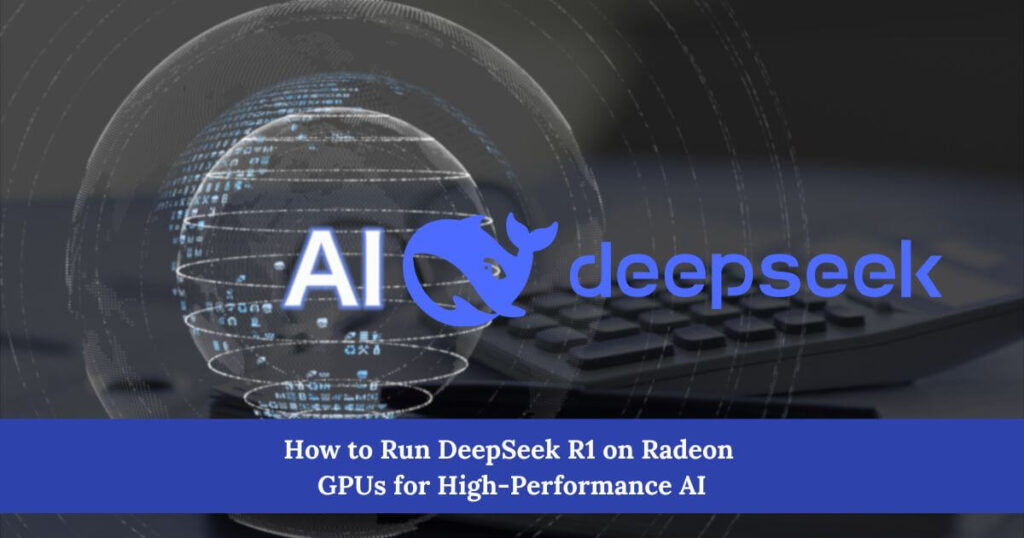As artificial intelligence (AI) has advanced significantly, so too has the need for powerful hardware to run intricate models. A state-of-the-art AI model called DeepSeek R1 is transforming how academics and developers work with machine learning (ML). When paired with AMD Radeon GPUs, DeepSeek R1 provides a productive and affordable AI experience.
The advantages, system requirements, performance optimization advice, and troubleshooting techniques of DeepSeek R1 on AMD Radeon GPUs are all covered in this article. This guide will assist you in maximizing the capabilities of DeepSeek R1 with Radeon GPUs, regardless of your background as an AI researcher, developer, or enthusiast.
Understanding DeepSeek R1 and Its Capabilities
Describe DeepSeek R1.
DeepSeek R1 is a sophisticated open-weight AI model that is similar to Claude 3 and GPT-4 Turbo. It is perfect for applications like chatbots, automation, and research because it is made to handle mathematical, coding, and reasoning tasks.
Essential Elements of DeepSeek R1
- Extremely Effective: For economical processing, a combination of small and large model designs is used.
- Supports a range of model sizes, from 1.5 billion to 671 billion parameters, making it scalable.
- Multimodal Capabilities: Handles several kinds of data, including text.
- Open-Source: MIT-licensed, permitting unrestricted integration and modification.
The Use of DeepSeek R1: Why?
Specifically, DeepSeek R1 is helpful for:
- developers creating apps driven by AI.
- Big databases are being analyzed by data scientists.
- AI is being used by businesses for automation and customer service.
- DeepSeek R1 is available on platforms such as Ollama.
The Power of AMD Radeon GPUs for AI Computing

Why Choose AMD Radeon for AI?
AMD Radeon GPUs are known for their high-performance computing (HPC) capabilities, making them a viable alternative to NVIDIA for AI workloads.
Key Benefits of Using AMD Radeon GPUs
- Cost-Effective: Radeon GPUs offer competitive pricing compared to NVIDIA.
- High Computational Power: The latest RDNA 3 architecture improves AI processing.
- AI-Optimized Memory: Supports models with large datasets.
Recommended AMD Radeon GPUs for DeepSeek R1
| GPU Model | VRAM | Best For | Supported Models |
|---|---|---|---|
| Radeon RX 7600 | 8GB | Basic AI models & testing | DeepSeek-R1 7B |
| Radeon RX 7800 XT | 16GB | Medium AI workloads | DeepSeek-R1 13B |
| Radeon RX 7900 XTX | 24GB | High-performance AI processing | DeepSeek-R1 32B |
If you’re handling large-scale AI training, consider AMD Instinct MI300 series for enterprise-grade performance.
3. Setting Up DeepSeek R1 on AMD Radeon GPUs
System Requirements
Before installing DeepSeek R1, ensure your system meets these requirements:
- Operating System: Windows 10/11 or Linux (Ubuntu 20.04+ recommended).
- GPU: Radeon RX 7000 series or later.
- VRAM: Minimum 8GB (higher models may need 16GB+).
- AMD ROCm (Radeon Open Compute): Required for AI acceleration.
Step-by-Step Installation Guide
- Update Your GPU Drivers
- Download the latest Radeon drivers from AMD’s official website.
- Install AMD ROCm for Linux users.
- Install Ollama (AI Model Runner)
- Download Ollama from ollama.com.
- Run the installation and restart your system.
- Download DeepSeek R1 Model
- Open a terminal and execute:
ollama pull deepseek-r1:7b - This command downloads the 7B parameter model (change
7bto13bor32bas needed).
- Open a terminal and execute:
- Run DeepSeek R1 on Your Radeon GPU
- Start the model using:
ollama run deepseek-r1:7b - Monitor GPU usage using tools like Radeon Software or Task Manager.
- Start the model using:
Tips for Performance Optimization
How to Increase DeepSeek R1’s Radeon GPU Performance and Reduce GPU Memory Usage
Optimize GPU Memory Usage
Choose a model that fits within your GPU’s VRAM.
Use quantization techniques to reduce model size.
Enable Hardware Acceleration
In AMD Adrenalin settings, enable AI acceleration and Compute Mode.
Fine-Tune AI Workloads
Utilize AMD’s ROCm for AI-specific optimizations.
Monitor and Adjust Power Settings
Increase GPU clock speeds using Radeon WattMan for better performance.
Enable FP16 (Half-Precision Mode)
Reduces memory consumption while maintaining accuracy.
Dealing with Typical Problems
Problem 1: Radeon GPUs Cause the Model to Run Slowly
Verify that ROCm is installed properly.
Reduce the GPU stress by lowering the batch size.
Problem 2: Memory Errors (VRAM Out)
Change to a smaller model (from 32B to 13B, for example).
AMD Infinity Cache can help you manage your memory better.
Problem 3: Issues with Compatibility
Make sure the most recent drivers are being used.
If you’re utilizing custom AI scripts, update your Python libraries.
See AMD Developer Forums for additional troubleshooting information.
Comparing AMD Radeon with NVIDIA for AI Workloads
| Feature | AMD Radeon RX 7000 Series | NVIDIA RTX 40 Series |
|---|---|---|
| Price | More affordable | Expensive |
| AI Software Support | ROCm (Linux support) | CUDA (Wider compatibility) |
| Performance | Excellent for inference | Best for training LLMs |
| Memory Efficiency | Infinity Cache improves performance | Faster VRAM |
While NVIDIA GPUs dominate AI training, AMD Radeon GPUs are a great alternative for local inference and cost-effective AI applications.
Future of AI with AMD Radeon GPUs
AMD is making significant investments in AI acceleration, and it is anticipated that the next RDNA 4 GPUs will provide improved AI performance. As the ROCm ecosystem grows, Radeon GPUs are becoming increasingly compatible with DeepSeek R1 and other AI models.
Future developments are probably going to include:
- More Radeon GPUs with AI optimization
- Improved compatibility with Windows drivers
- Increased speed at which AI inference occurs
- Keep an eye out for further developments on AMD’s AI agenda.
Conclusion
A fantastic option for a high-performance, reasonably priced AI solution is to pair AMD Radeon GPUs with DeepSeek R1. Radeon GPUs are a powerful substitute for NVIDIA in AI inference, even if NVIDIA remains the industry leader in AI training.
Who Needs to Use AMD Radeon’s DeepSeek R1?
✅ Developers creating AI applications and chatbots
✅ Researchers in need of a reasonably priced AI inference setup
✅ Local tech enthusiasts experimenting with AI





